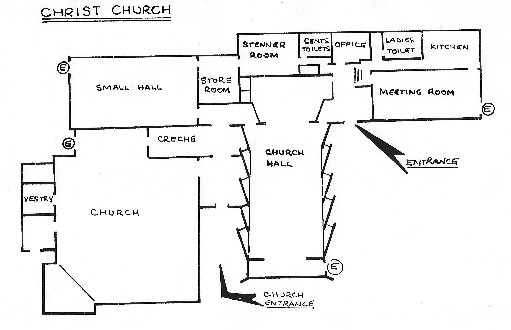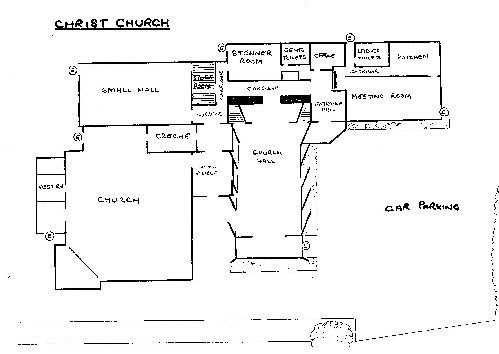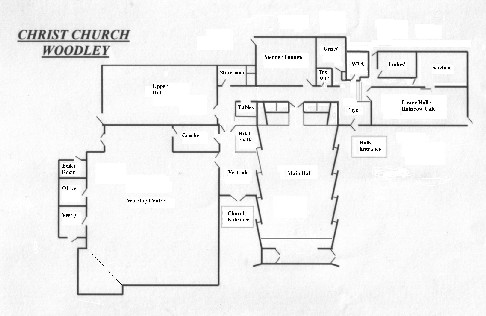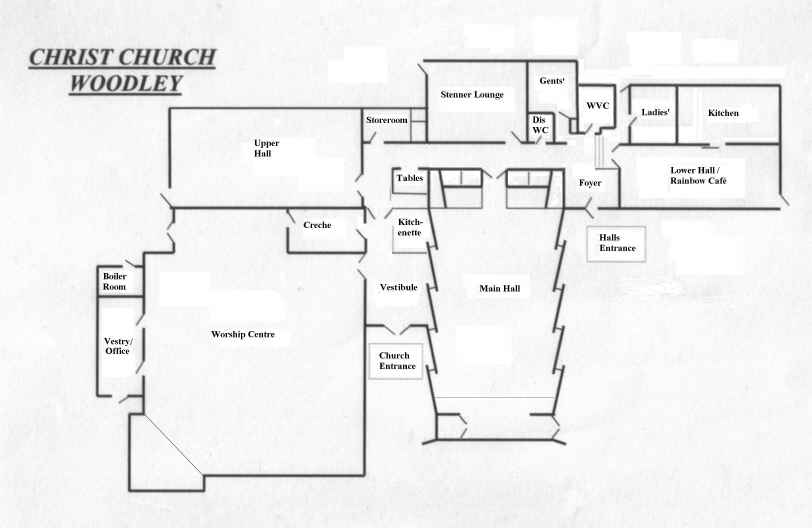The Methodist Church - The Later Years - and Union


The first church was a dual purpose hall, with a sanctuary area at the end nearest to Crockhamwell Road and a stage at the other end, between the two doors. This gave a seating limit of about 100 loose chairs. The stage was later removed to give increase seating by about 50 as the Sunday services filled up. There was also a meeting room (now the Lower Hall), a vestry (now the Volunteer Centre), a small kitchen off the meeting room and toilets off off the coridor leading to the kitchen.
The premises have since been adapted and changed quite frequently. A hall was added, known at first by its main use as the Scout Hut and later renamed the Upper Hall when the scouts moved to their own HQ. In about 1976, a much needed store room and a further small meeting room was added on the north side, along with relocated toilets. The meeting room was named the Stenner Room after a much loved church member who had recently died. Mr E J (Jim) Stenner (c1891-c1978) was a retired estate gardener and a local preacher who had a wise word and a warm smile for all. He was responsible for the original planting of shrubs in the church grounds.
The old Methodist Church, now the Main Hall, began to get quite full. During the time when Revd. David Le Poidevin was the Minister, well before the joining of the Methodist and URC congregations, there were signs of over-crowding. When the Sunday School came into Church to share in a service of Baptism the youngest children sat on the dais around the minister's feet. His progress to the font, baby in arms, was very cautious!
A Church Meeting discussed what form a new Church building should take. Suggestions were submitted from two builders.
The high ceiling of the old Church was liked: the new Church should feel spacious. However the old Church had narrow windows: the new Church should be bright. (The present Main Hall has extra windows added after the new Church was built. Its original windows were designed to be invisible to the congregation, but to light the front of the Church.)
Both requirements were met by a design submitted by Stocks Bros (Buildings) Ltd of Garforth near Leeds. The design was square, but an extension at one corner gave a sanctuary area. This extended corner design was inspired by the example of a church outside Bristol which the Rev Bernard Arnold and a small group went to see. Care had been taken to link the old and new buildings as well as appeared possible. The suggested vestibule area was small, but a slightly enlarged version was possible. A crèche was also requested. (This has recently been altered to give a smaller crèche which is completely separate from the corridor and coat hanging space, so that the toddlers can be more securely supervised). Pews were considered, but chairs were chosen, so that seating could be re-arranged easily. Apart from an extension of the proposed vestibule area (did we always linger to chat?) and the inclusion of a crèche, the Stocks design was approved. The windows in the sanctuary area were left plain with the possibility of stained glass sometime in the future.
The whole building was situated on a floating concrete raft. The walls were "hung" onto a steel frame. The roof section was constructed first and, for a short time, stood on the concrete base. A passing child was heard to ask its mother what the big climbing frame was for! However, the main upright steel members were quickly put into place and the roof was raised, not by singing, but by a crane!
John Ogden, then Chairman of the Property and Finance Committee, liaised with the builders throughout the planning and building process assisted by Reg Crisp, then the Senior Property Steward, and Stein Ingolfsrud. Cost was estimated at £98000, including the landscaping and carpark extension, and was to be funded by a grant from the Methodist Circuit (£65000) and one from the URC, by money already saved up (£2500) and by gifts and loans from members and friends of the church.
On completion in August 1982 the new Church was generally agreed to be a beautiful place in which to worship.
That same year the Methodist and URC churches came together and worshipped in the new Church. It didn't seem so very large when we all got together!
The name of the new Church was a cause for debate. Christ Church was a happy choice, since the Church on Loddon Bridge Road had been known as Christchurch for part of its life.
The formal basis for the joint worship of the two congregations was a sharing agreement concerning the premises and a Constitution designed to work for members of both traditions. The Constitution was drawn up after numerous meetings of representatives from both Churches. The Methodist Minister, the Rev. Bernard Arnold was joined by John Ogden and John Phillippo while Rev. Hazel Day, Geoff Sargent, Richard Norris and Marion Rozzier represented the URC.
The URC practice had been to govern the Church by meetings of the complete membership. The various administrative tasks and pastoral oversight (in addition to that provided by the Minister) were performed by ordained Elders of the Church. Ordination to the Eldership was life long, although an ordained Elder might fill various positions at different times and sometimes be 'non-serving'.
The Methodist Church had a legal obligation to have a Church Council whose members would act as trustees for the building, although day to day control of the building was the responsibility of the Finance and property committee. This did not preclude meetings of the whole membership and, indeed, any interested parties to discuss Church business, voting rights being confined to members. The various Church offices of Stewards, Class leaders Church Council members etc. were by election and (if formally instituted) by commissioning for an appropriate time - not life-long!
The constitution allowed for the continuance of the Church Council and for Church Meetings. The regular Church meetings are not as frequent as the URC members were used to. However it is always possible to convene extraordinary meetings. The Church Council currently meets once a year as a separate entity, but is also present concurrently with the Church Meeting so that any business specific to the Church Council can be dealt with. Another development from the decisions on frequency of Church Meetings was the authorisation of the Stewards to act on behalf of the Church Meeting when minor decisions were required urgently, although major matters would require discussion by the Church Meeting.
We now have some freedom in choosing whether to commission or ordain members to various offices - indeed the prospective officers may have their own preferences. On Union some of the serving elders of the URC joined an enlarged Stewards' rota. Some of the URC Elders had pastoral oversight of members while the Methodist church had Class Leaders who looked after groups which had started meeting in 'classes' reviving a concept which had been moribund in many Methodist congregations. We now have Pastoral groups which meet regularly. The possible forms which individual group meetings may take include discussion, Bible study, musical evenings and barbeques organised by Pastoral Group Leaders. A new use of the term 'Elder' developed when four Pastoral Elders were appointed to be available to advise and support the Pastoral Group Leaders in their work.
Throughout the various Church Committees a merging of personnel from equivalent structures was achieved. Now the congregations have grown together.
The sanctuary area was completed with clear windows, with a suggestion that the windows could be improved when funds allowed. The idea of stained glass windows was debated in a Church Meeting and caused some consternation, as it was difficult to see what type of design would be appropriate. Traditional stained glass was both expensive and might look strange in a modern building - yet abstract designs had a limited appeal to the meeting. The question was kept open by deciding that 'coloured glass' might one day appear.
Stained glass windows became a possibility when the Church received a legacy from Grace Bradley. She had been a member of the URC Church on Loddon Bridge Road. At the time of the union of the two churches she was unwell and unable to worship at Christ Church.
This appeared to be the moment for the Church to finalise plans and install windows in the Sanctuary area.
There was a possibility of obtaining part of a collection of stained glass rescued from an old Church. However the alteration in size required and the obvious age of the design would have had a rather odd effect.
Mr Johns, a professional sculptor and designer of Church Furnishings, was living in Woodley when discussion started and made a sketch of a more modern window on a Biblical theme. However some members expressed a desire to have something closely linked with Woodley.
Later Mrs. Ruth Arnold, the wife of Revd Bernard Arnold, our Methodist Minister at the time, brought to a church meeting a design that linked both God's rainbow promise and elements of Woodley in the past and the present. That design formed the basis for the final design. Ruth's account of the meaning of the windows, in her own beautiful script, can be seen to one side of the doors at the back of the Church.
The windows were installed in 1986, the Dedication Service being held on Sunday 25 May at the morning service.
The total cost was £3581 of which a substantial part was met by the legacy, topped up with the approval of the Church.
In 1985 the side windows of what was now the Main Hall (Coventry Cathedral style throwing light forward to the sanctuary area, but rather small) were supplemented by new windows cut into the slab shaped walls on one side. In the same year the two entrance doors were converted into cupboard doors and a new central door constructed. This alteration was worked out by Mr Reg Crisp who was then senior property steward and Mr Don White, also a property steward, to overcome a problem of layout. The premises had grown piecemeal without space being set aside for access, so that access to several rooms entailed passing through the old church (later renamed the Main Hall). The new layout allowed part of the old stage area to become a main corridor, with other minor alterations to door positions on other rooms completing a through route giving easy access to every room. The layout is shown here before and after building the corridor:


At some point the old spire on what was now the hall was removed.
Finance for a considerable amount of improvement was provided by a gift of £30000 from the proceeds of the sale of the old URC church and hall. Another £30000 went initially to the URC central funds and then became part of the £50000 contributed by the URC to Trinity Church, Lower Earley. Trinity Church came into being initially through the joint work of Woodley Methodist Church and Park URC Church, Reading. The Anglican Church also took part in time for the three denominations to contribute equally to the building fund.
Further work in 2005 saw the installation of a disabled toilet and a kitchen refurbishment ready for the Rainbow Café, which opened in February 2006. In 2007 the Stenner Lounge was redecorated and a patio area was created behind the kitchen.
During 2015 the main corridor was rebuilt to lower the slope of the ramp, and the vestibule area altered to provide a kitchenette and the top hall was refurbished. In summer 2018 the wall between the office and vestry was removed to make a combined vestry-office that could also be used for small meetings. In Summer 2019 the kitchen was enlarged and the ladies' toilet was reorganised, abolishing the kitchen corridor.
The layout before the kitchen and vestry change, and the current room layout:


Page last updated 1st September 2020.